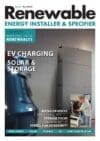
As the UK aims for a 78% carbon emission reduction by 2035 and Net Zero by 2050, low to zero carbon heating solutions, including hot water cylinders, will become critical to achieving this target. While there are currently nine million cylinders in England, just under 45% of homes have one installed, a decline from 77% in 2001.
The UK has excelled in recent years in producing renewable energy, often witnessing days where no reliance on fossil fuels for electricity generation is necessary, proving that a renewable transition is achievable.
When it comes to heating systems specifically, new HWA research has revealed how the future of renewables can be unlocked through the integration of hot water cylinders.
Harnessing energy stores
The HWA’s latest report, Connected Homes, spotlights the role of hot water cylinders as long-term energy stored. Thermal energy storage incorporates a range of hot water and thermal store cylinder solutions that store energy as heated water.
From low-temperature domestic hot water storage to high-temperature process heat to large district heating buffers, the application is universal. This is notable in the millions of hot water cylinders installed and maintained by heating engineers in homes across the UK.
For use in the home, hot water cylinders must work smartly if they are to be used as energy storage. Indirect cylinders with electric immersion heaters that are to be used as an energy store – either by sourcing energy directly from the grid or from solar photovoltaic sources should be paid significant attention.
If it is a connected appliance, such as a heat pump, prime performance can be achieved through control of the heat source.
Fitting a cylinder with built-in smart abilities or retrofitting the cylinder with smart controls allows customers to control hot water schedules with an app while also providing additional energy consumption insights.
If the consumer prefers, control can also be outsourced to third parties, with a plethora of choice facing homeowners. They can choose between the smart control within the appliance, retrofitting a thermostat, connected to a switchboard or smart plug, or embedding a Wi-Fi module. Here, there is a vital role for installers and heating engineers, as they can use their knowledge and expertise to inform consumers of the right choice, dependent on their requirements.
So, what’s in it for consumers?
In short, the benefits are substantial. By optimising hot water cylinder heating to take advantage of lower electricity prices during off- peak hours, customers can reduce their energy bills. A similar approach in Ireland has already proven successful, facilitating renewable energy adoption while helping many fuel-poor homes. Research showed that equipping 450,000 Irish homes with smart cylinder technology could accommodate around 90% of curtailed wind power.
Homeowners can also increase self- consumption of solar energy by directly using solar electricity generated during the day to heat water in the cylinder, avoiding the need to sell excess energy back to the grid at a lower price or to install costly batteries.
The connectivity and flexibility of hot water cylinders enable more inclusive uptake of decarbonised technologies. According to the Connected Homes report, heat pumps paired with cylinders are projected to rise 651% by 2030.
Heating water during times of abundant renewable supply brings customers closer to decarbonising home energy use without severe upfront costs. This can also provide low-carbon solutions for social housing and homeowners with limited funds for green upgrades.
However, policy reforms are needed to lower costs and encourage these upgrades. Retrofitting a cylinder with smart capabilities ranges from £100-£2,000. Introduction of grants and incentives is essential to provide the financial support required to spur adoption.
An achievable, flexible future?
UK homes use 250 Gigawatt hours of electricity per day. The Connected Homes report envisions hot water cylinders as batteries for grid electricity, unlocking 23 Gigawatt hours if smartly connected. However, to release this potential, smart functionalities must be integrated and collaboration between industry, government, and homeowners must be achieved.
Faced with a myriad challenges – from soaring costs of living, to reduced support on energy pricing – many households are struggling. In this current landscape the significance of renewable sources such as heat pumps and solar panels will no doubt escalate.
As highlighted in our report, calculations reveal the potential for households to save £200 per year by optimising their hot water cylinder usage with clean energy or time of use tariffs. For consumers to successfully benefit in this way, we must provide robust mechanisms to stimulate uptake of hot water cylinders via grants or similar incentives as well as encourage the use of smart controls.
Energy security and resilience will sit at the centre of debate for years to come. Thankfully, smart cylinders can be used to mitigate the risk of outages during peak demand, providing peace of mind to both grid providers who face fines in the event of disruption, as well as customers who are determined to reduce their energy bills.
Image credit: Hot Water Association




